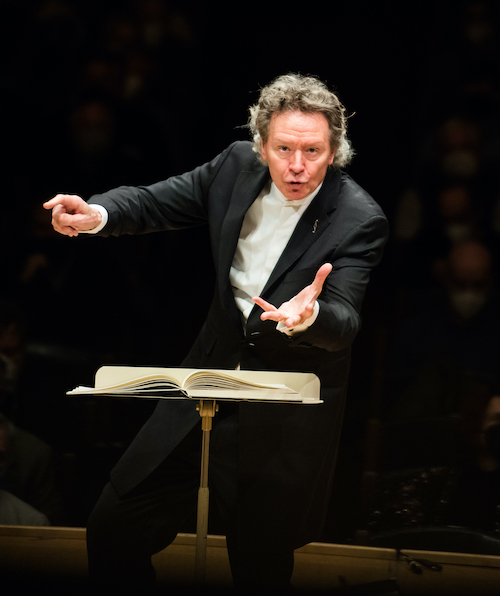Christophers, Handel & Haydn Society bring stylish vigor to Haydn-Mozart tripych

Harry Christophers conducted the Handel & Haydn Society Sunday afternoon at Symphony Hall. Photo: Sam Brewer
Neither snow nor ice nor frigid temperatures stayed the Handel & Haydn Society from their appointment Sunday afternoon. One day after a Nor’easter dropped nearly two feet of snow on Boston and as the thermometer hovered near the single digits, H&H and music director Harry Christophers were back at Symphony Hall with a program of pieces by Wolfgang Amadé Mozart and Franz Josef Haydn.
The afternoon’s offerings were something of a study in chronological opposites. The Haydn selections—his Symphony No. 103 in E-flat and the Theresienmesse—were written by an established master at the end of a long career. Mozart’s Violin Concerto No. 1, on the other hand, was penned by a seventeen-year-old.
Nevertheless, for freshness, tunefulness, and sheer musical invention, the triptych fit together smartly, each component complementing the other well.
In Haydn’s symphony, written in 1795, Christophers drew playing of dash and spirit from his forces. The first movement’s introductory play of contrasts—taut timpani riffs alternating with darkly glowing low-string melodies—proved bracing. Meanwhile, the Allegro proper danced energetically.
Droll charm reigned in the Andante’s variations, whose witty contrapuntal episodes—highlighted by concertmaster Aisslinn Nosky’s tastefully vigorous solos—unfolded with enchanting naturalness and style.
Christophers ably teased out the subtleties of the Minuet, particularly the trio’s lovely blend of instrumental colors, and drew heat from his players in the finale’s minor turns. Rhythmic energy never sacrificed textural clarity; this was an admirably balanced reading in which the music’s moving parts spoke clearly as they should.
That same quality marked Christophers and the ensemble’s approach to the Mass.
The twelfth of Haydn’s fourteen masses, the Theresienmesse dates from 1799. While this setting of the Ordinary doesn’t pack any innovative surprises, its crafty blend of solo vocal quartet, choir, and orchestra offers no shortage of delights. And on Sunday these came from all directions.
Technically, Christophers’ was an accomplished interpretation, one that discreetly underlined the score’s various tripartite structural schemes and neatly tied together its periodically recurring motives.
Balances were carefully observed. Singing with exceptional tonal blend, diction, and feel for Haydn’s style, the H&H Chorus was characteristically flawless. In this context, the excellent quartet of soloists—soprano Mary Bevan, mezzo-soprano Catherine Wyn-Rogers, tenor Jeremy Budd, and baritone Sumner Thompson—simply sounded like an intimate extension of that larger group.
Accordingly, the mass’s dramatic structure, much of which derives from the juxtaposition of the choral and solo elements, came across powerfully. Its big moments, like the Kyrie’s vigorous central fugue and the Credo’s robust opening statement, were visceral. But just as affecting, inwardly, were the flowing solos in the Gratias (particularly those from Bevan and Wyn-Rogers) and the quartet’s haunting account of the Et incarnatus est.
For his part, Christophers saved the afternoon’s most potent moments for the Agnus Dei, whose refrains were shaped with uncommon fervency. The concluding Dona nobis pacem, while largely consolatory, seemed to harbor some doubts: all may be well, eventually, it suggested—but not necessarily quickly or easily.
No such clouds darken Mozart’s Violin Concerto in B-flat-major. As played and led on Sunday by concertmaster Nosky, it’s music of sunshine and warmth.
Nosky’s account of the solo line was, generally, extroverted and lyrical. A few pitch issues aside (there was some noticeable retuning from the soloist between sections), she navigated the outer movements’ bravura turns vigorously and without losing sight of the latent songfulness of her larger approach to the piece. The pithy first-movement cadenza was played with conspicuous precision of character.
Throughout, the orchestra’s accompaniments were well-directed and -balanced. In the Adagio, the strings’ rolling textures painted a picture of bucolic charm. Yet their fast-movement articulations were consistently spirited, particularly in the finale, whose contrapuntal textures gamboled knowingly.
The Handel & Haydn Society next performs music by J. S. Bach 7:30 p.m. February 4 at Jordan Hall. handelandhaydn.org
Posted in Performances





